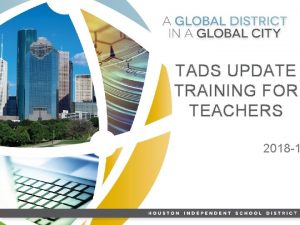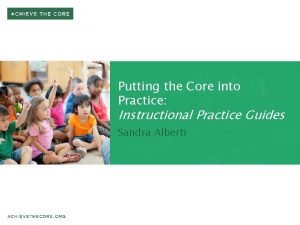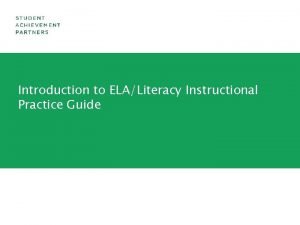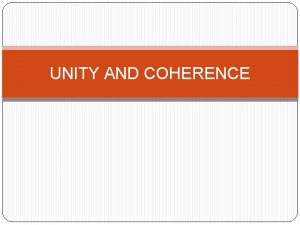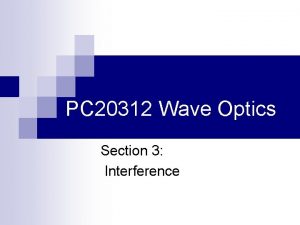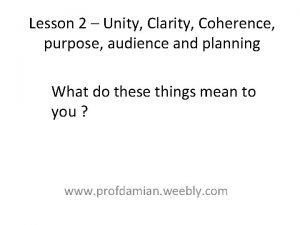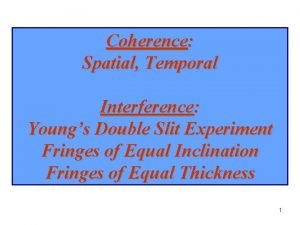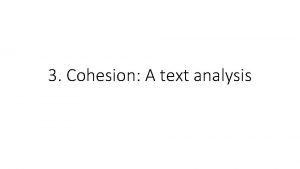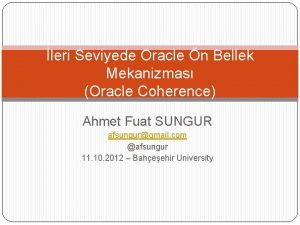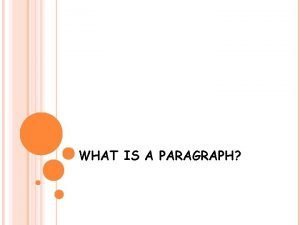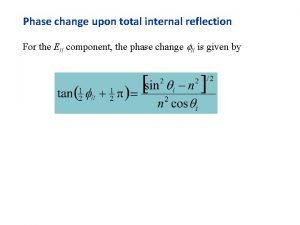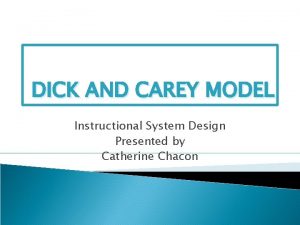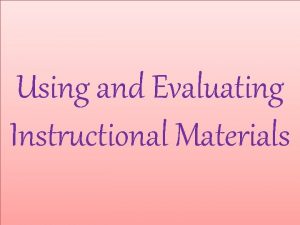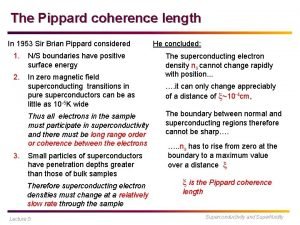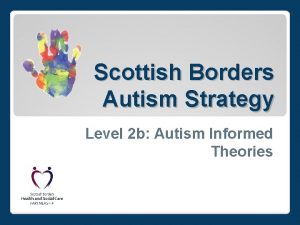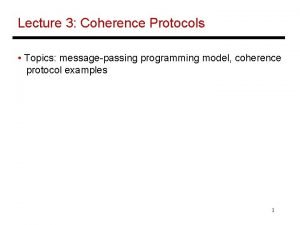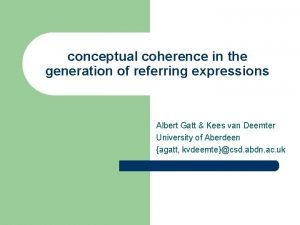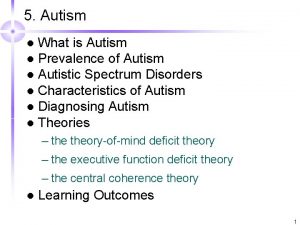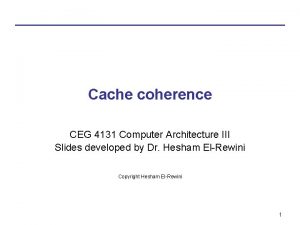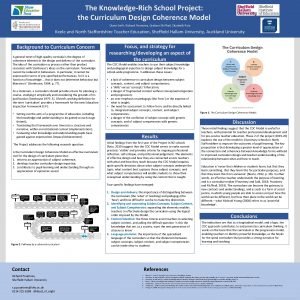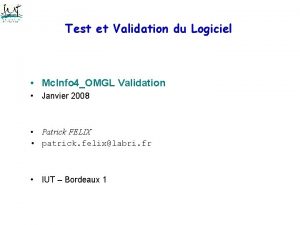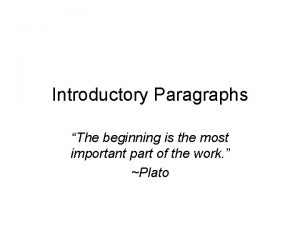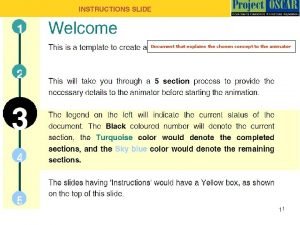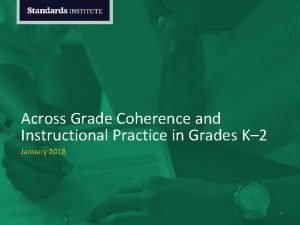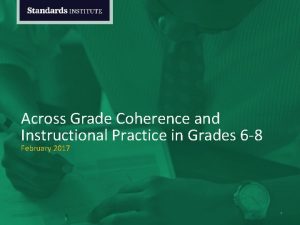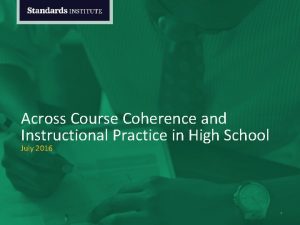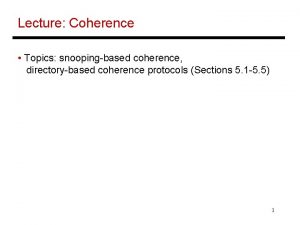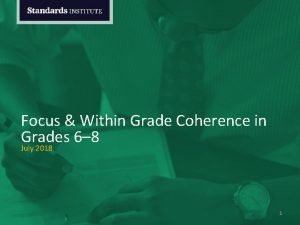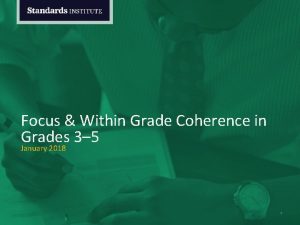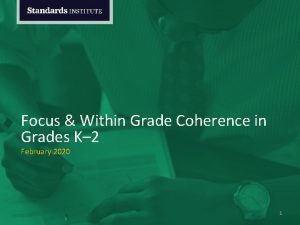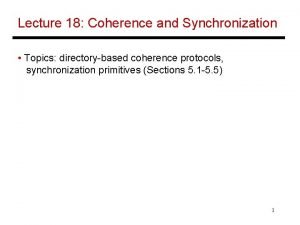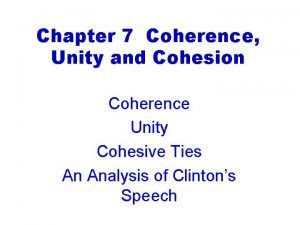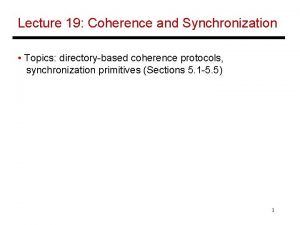Across Grade Coherence and Instructional Practice in Grades































































- Slides: 63

Across Grade Coherence and Instructional Practice in Grades 3 -5 July 2016 1

ACROSS GRADE COHERENCE IN GRADES 3 -5 Welcome Back! 2

ACROSS GRADE COHERENCE IN GRADES 3 -5 Thank You For Your Feedback! + 3

ACROSS GRADE COHERENCE IN GRADES 3 -5 Norms That Support Our Learning • Take responsibility for yourself as a learner • Honor timeframes (start, end, activity) • Be an active and hands-on learner • Use technology to enhance learning • Strive for equity of voice • Contribute to a learning environment in which it is “safe to not know” 4

ACROSS GRADE COHERENCE IN GRADES 3 -5 This Week Day Ideas Monday Focus and Within Grade Coherence Tuesday Wednesday Rigor and the Mathematical Practices Across Grade Coherence and Instructional Practice Thursday Adaptation and Curriculum Study Friday Adaptation and Practice “Do the math” Connect to our practice 5

ACROSS GRADE COHERENCE IN GRADES 3 -5 Today • Morning: Across Grade Coherence in Grades 3 -5 • Afternoon: Instructional Practice in Grades 3 -5 6

ACROSS GRADE COHERENCE IN GRADES 3 -5 Morning Objectives • Participants will be able to clearly define the across-grade part of the coherence shift. • Participants will be able to describe the rationale for across grade coherence. • Participants will be able identify at least 3 prerequisites for a standard in their grade. • Participants will be able to adapt a lesson for students below grade level by adding just-in-time scaffolds based on progressions of content. 7

ACROSS GRADE COHERENCE IN GRADES 3 -5 Morning Agenda I. Across Grade Coherence II. Vertical Coherence Challenge III. Mapping the Progressions IV. Tools for Understanding the Progressions V. Adapting Lessons for Students Below Grade Level 8

ACROSS GRADE COHERENCE IN GRADES 3 -5 Across Grade Coherence • 9

ACROSS GRADE COHERENCE IN GRADES 3 -5 What is the Right Order? Grade 4 Explain why a fraction a/b is equivalent to a fraction (n × a)/(n × b) by using visual fraction models, with attention to how the number and size of the parts differ even though the two fractions themselves are the same size. Grade 3 Understand two fractions as equivalent (equal) if they are the same size, or the same point on a number line. Grade 5 Interpret multiplication as scaling (resizing) by…relating the principle of fraction equivalence a/b = (n × a)/(n × b) to the effect of multiplying a/b by 1. 10

ACROSS GRADE COHERENCE IN GRADES 3 -5 Coherence is Key “A focused, coherent progression of mathematics learning, with an emphasis on proficiency with key topics, should become the norm in elementary and middle school mathematics curricula. Any approach that continually revisits topics year after year without closure is to be avoided. By the term focused, the Panel means that curriculum must include (and engage with adequate depth) the most important topics underlying success in school algebra. By the term coherent, the Panel means that the curriculum is marked by effective, logical progressions from earlier, less sophisticated topics into later, more sophisticated ones. Improvements like those suggested in this report promise immediate positive results with minimal additional cost. ” - National Mathematics Advisory Panel 11

ACROSS GRADE COHERENCE IN GRADES 3 -5 The Progressions 12

Across Grade Coherence: Learning is carefully connected across grades so that students can build new understanding onto foundations built in previous years.

ACROSS GRADE COHERENCE IN GRADES 3 -5 Vertical Coherence Challenge • In your groups, you have 11 standards on pieces of paper. Most standards come from the Number & Operations--Fractions domains in grades 3 -5. • The standards are not labeled! • Determine which standards are prerequisites for other standards. • Bonus: Can you determine which standards belong in which grade? 14

ACROSS GRADE COHERENCE IN GRADES 3 -5 A Picture of Coherence Grade 2 2. G. A. 3 A Grade 3 Grade 4 3. NF. A. 1 D 3. NF. A. 3 G 4. NF. A. 1 4. NF. A. 2 5. NF. A. 1 5. NF. A. 2 I E C H 4. NF. B. 3 4. NF. C. 5 B 2. MD. B. 6 K Grade 5 J 3. NF. A. 2 F 15

ACROSS GRADE COHERENCE IN GRADES 3 -5 Progressions of Content • How does understanding the progression of content support our understanding of gradelevel content? • How does understanding the progression of content help us support students below grade level? 16

ACROSS GRADE COHERENCE IN GRADES 3 -5 Standards Mapping Protocol: • Identify 3 prerequisite standards – the standards do not have to be in 3 different grades. • Identify the aspects of rigor for each prerequisite. • Discuss with a partner: 1. How does each prerequisite support the standard? 2. Why is it important to pay attention to the rigor of the prerequisite standard? The Standards: Grade 3 – 3. OA. A. 2 Grade 4 – 4. OA. A. 3 Grade 5 – 5. NBT. B. 7 17

ACROSS GRADE COHERENCE IN GRADES 3 -5 Grade 3 – 3. OA. A. 2 Interpret whole-number quotients of whole numbers, e. g. , interpret 56 ÷ 8 as the number of objects in each share when 56 objects are partitioned equally into 8 shares, or as a number of shares when 56 objects are partitioned into equal shares of 8 objects each. For example, describe a context in which a number of shares or a number of groups can be expressed as 56 ÷ 8. 3. OA. A. 1 Interpret products of whole numbers, e. g. , interpret 5 X 7 as the total number of objects in 5 groups of 7 objects each. 2. OA. C. 4 Use addition to find the total number of objects arranged in rectangular arrays with up to 5 rows and up to 5 columns; write an equation to express the total as a sum of equal addends. 1. OA. D. 7 Understand the meaning of the equal sign, and determine if equations involving addition and subtraction are true or false. 18

ACROSS GRADE COHERENCE IN GRADES 3 -5 Grade 4 – 4. OA. A. 3 Solve multi-step word problems posed with whole numbers and having whole -number answers using the four operations, including problems in which remainders must be interpreted. Represent these problems using equations with a letter standing for the unknown quantity. Assess the reasonableness of answers using mental computation and estimation strategies including rounding. 4. OA. A. 2 Multiply or divide to solve word problems involving multiplicative comparison, e. g. , by using drawings and equations with a symbol for the unknown number to represent the problem, distinguishing multiplicative comparison from additive comparison. 3. OA. D. 8 Solve two-step word problems using the four operations. Represent these problems using equations with a letter standing for the unknown quantity. Assess the reasonableness of answers using mental computation and estimation strategies including rounding. 2. OA. A. 1 Use addition and subtraction within 100 to solve one- and two-step word problems involving situations of adding to, taking from, putting together, taking apart, and comparing, with unknowns in all positions, e. g. , by using drawings and equations with a symbol for the unknown number to represent the problem. 19

ACROSS GRADE COHERENCE IN GRADES 3 -5 Grade 5 – 5. NBT. B. 7 Add, subtract, multiply, and divide decimals to hundredths, using concrete models or drawings and strategies based on place value, properties of operations, and/or the relationship between addition and subtraction; relate the strategy to a written method and explain the reasoning used. 4. NBT. A. 1 Recognize that in a multi-digit whole number, a digit in one place represents ten times what it represents in the place to its right. For example, recognize that 700 ÷ 70 = 10 by applying concepts of place value and division. 4. NBT. B. 4 Fluently add and subtract multi-digit whole numbers using the standard algorithm. 4. NBT. B. 5 Multiply a whole number of up to four digits by a one -digit whole number, and multiply two-digit numbers, using strategies based on place value and the properties of operations. Illustrate and explain the calculation by using equations, rectangular arrays, and/or area models. 20

Break

ACROSS GRADE COHERENCE IN GRADES 3 -5 Understanding the Progressions Content Guides The Progressions Documents Wiring Diagram 22

How can we leverage Leveraging the Progressions progressions of content to give students access to grade-level content? ACROSS GRADE COHERENCE IN GRADES K-2 23

ACROSS GRADE COHERENCE IN GRADES 3 -5 Adapting Lessons for Students Below Grade Level Protocol: • Review Lesson 1 and identify the targeted standard. • Identify the prerequisite standards from prior grades that support the targeted standard. o What is the aspect of rigor for each prerequisite? • Discuss with a partner: 1. How does each prerequisite support the standard? 2. How could you strategically use these prerequisite standards to support students who are not on grade level? o Annotate the lesson with specific supports. • With your table: o Each pair shares out the specific adaptations you and your partner made. Explain why you made these adaptations. 24

ACROSS GRADE COHERENCE IN GRADES 3 -5 Adapting Lessons for Students Below Grade Level Protocol: time • 10 min: Individual work time • 15 min: Partner work • 10 min: Table share out Goals for this activity: I. Review Lesson 1 and identify the targeted standard(s). II. What are the prerequisite standards from prior grades that support this standard(s)? III. What aspects of rigor are highlighted in the prerequisite standards? 25

Transition to Partner Time! 26

ACROSS GRADE COHERENCE IN GRADES 3 -5 Adapting Lessons for Students Below Grade Level Goals for this activity: Protocol: time • 10 min: Individual work time • 15 min: Partner work • 10 min: Table share out I. II. How do these prerequisite standards support the grade-level standard(s)? How could you strategically use these prerequisite standards to support students who are not on grade level? o Annotate the lesson with specific supports 27

Transition to Table Share! 28

ACROSS GRADE COHERENCE IN GRADES 3 -5 Adapting Lessons for Students Below Grade Level Protocol: time • 10 min: Individual work time • 15 min: Partner work • 10 min: Table share out Goals for this activity: o Each pair shares out the specific adaptations made and explains why these adaptation were made. 29

ACROSS GRADE COHERENCE IN GRADES 3 -5 Adapting Lessons for Students Below Grade Level What grade level standard does the lesson address? What is the evidence of alignment to this standard? What are the prerequisite standards from prior grades that support this standard? Brainstorm ways you could use these prerequisites to support students below grade level with accessing the content of this lesson. • Annotate the lesson with specific supports. 30

ACROSS GRADE COHERENCE IN GRADES 3 -5 Summary What is the shift of coherence? How does understanding the progression of content help us support students below grade level? 31

ACROSS GRADE COHERENCE IN GRADES K-2 Lunch 12: 00 -1: 00 Lunch 12: 00 – 1: 00 32

INSTRUCTIONAL PRACTICE IN GRADES 3 -5 Today • Morning: Across Grade Coherence in Grades 3 -5 • Afternoon: Instructional Practice in Grades 3 -5 33

INSTRUCTIONAL PRACTICE IN GRADES 3 -5 Afternoon Objectives • Participants will be able to use the Instructional Practice Guide (IPG) as a lesson planning tool and a coaching tool. • Participants will be able to identify where, in lessons and videos, teachers engage in Core Actions. 34

INSTRUCTIONAL PRACTICE IN GRADES 3 -5 Afternoon Agenda I. Intro to the Instructional Practice Guide (IPG). II. Core Actions in Action! III. Lesson Planning with the IPG. IV. Connect to Practice. 35

INSTRUCTIONAL PRACTICE IN GRADES K-2 . . . effective teaching is the non-negotiable core that ensures that all students learn mathematics at high levels. . . Instructional Practice - Principles to Actions: Ensuring Mathematical Success for All (NCTM) 36

INSTRUCTIONAL PRACTICE IN GRADES 3 -5 Instructional Practice Guide (IPG) The Instructional Practice Guide includes coaching and lesson planning tools to help teachers and those who support teachers to make the Key Shifts in instructional practice required by the Common Core State Standards (CCSS). 37

INSTRUCTIONAL PRACTICE IN GRADES 3 -5 Core Actions 1. Ensure the work of the lesson reflects the Shifts required by the CCSS for Mathematics. 2. Employ instructional practices that allow all students to learn the content of the lesson. 3. Provide all students with opportunities to exhibit mathematical practices while engaging with the content of the lesson. 38

INSTRUCTIONAL PRACTICE IN GRADES 3 -5 Core Action 1 Ensure the work of the lesson reflects the Shifts required by the CCSS for Mathematics. Indicators A. The lesson focuses on the depth of grade-level cluster(s), grade-level content standard(s) or part(s) thereof. B. The lesson intentionally relates new concepts to students’ prior skills and knowledge. C. The lesson intentionally targets the aspect(s) of rigor (conceptual understanding, procedural skill and fluency, application) called for by the standard(s) being addressed. 39

INSTRUCTIONAL PRACTICE IN GRADES 3 -5 Core Action 2 Employ instructional practices that allow all students to learn the content of the lesson. Indicators A. The teacher makes the mathematics of the lesson explicit by using explanations, representations, and/or examples. B. The teacher provides opportunities for students to work with and practice grade-level problems and exercises. C. The teacher strengthens all students’ understanding of the content by sharing a variety of students’ representations and solution methods. D. The teacher deliberately checks for understanding throughout the lesson and adapts the lesson according to student understanding. E. The teacher summarizes the mathematics with references to student work and discussion in order to reinforce the focus of the lesson. 40

INSTRUCTIONAL PRACTICE IN GRADES 3 -5 Core Action 3 Provide all students with opportunities to exhibit mathematical practices while engaging with the content of the lesson. Indicators A. The teacher poses high-quality questions and problems that prompt students to share their developing thinking about the content of the lesson. Students share their developing thinking about the content of the lesson. B. The teacher encourages reasoning and problem solving by posing challenging problems that offer opportunities for productive struggle. Students persevere in solving problems in the face of initial difficulty. C. The teacher establishes a classroom culture in which students explain their thinking. Students elaborate with a second sentence (spontaneously or prompted by the teacher or another student) to explain their thinking and connect it to their first sentence. 41

INSTRUCTIONAL PRACTICE IN GRADES 3 -5 Core Action 3 – Indicators (cont’d) D. The teacher creates the conditions for student conversations where students are encouraged to talk about each other’s thinking. Students talk about and ask questions about each other’s thinking, in order to clarify or improve their own mathematical understanding. E. The teacher connects and develops students’ informal language to precise mathematical language appropriate to their grade. Students use precise mathematical language in their explanations and discussions. F. The teacher establishes a classroom culture in which students choose and use appropriate tools when solving a problem. Students use appropriate tools strategically when solving a problem. G. The teacher asks students to explain and justify work and provides feedback that helps students revise initial work. Student work includes revisions, especially revised explanations and justifications. 42

INSTRUCTIONAL PRACTICE IN GRADES 3 -5 Deeper Dive With the IPG Small Group Protocol • Read the indicators of the Core Action for your group (pp. 5 -10). • Discuss the following with your small group: 1. How does this Core Action (including the indicators) support teachers and coaches in building understanding of CCSSM-aligned instruction? 2. What are the essential teacher practices that support the Indicators? 3. What resonates with you the most about this Core Action? 43

INSTRUCTIONAL PRACTICE IN GRADES 3 -5 Deeper Dive With the IPG Table Discussion Protocol • Turn and teach. • Discuss the following with your table group: 1. How does this tool support teachers and coaches in building understanding of CCSSM-aligned instruction? 2. What are essential teacher practices that support each Core Action? 3. Where do each of the Standards for Mathematical Practice show up in the IPG? 44

INSTRUCTIONAL PRACTICE IN GRADES 3 -5 Deeper Dive With the IPG Whole Group Discussion Protocol 1. 2. 3. How does this tool support teachers and coaches in building understanding of CCSSM-aligned instruction? Where do each of the Standards for Mathematical Practice show up in the IPG? What Core Actions are you most struck by and why? 45

INSTRUCTIONAL PRACTICE IN GRADES 3 -5 IPG Summary • Useful in both planning & coaching • Evidence for the indicators can come from lesson materials, teacher actions, student discussion and student work • When using as a coaching tool, not all indicators may be evident in a single class period • Not to be used as an evaluation instrument 46

INSTRUCTIONAL PRACTICE IN GRADES 3 -5 Core Actions in Action! What Core Actions are visible? 47

Break

INSTRUCTIONAL PRACTICE IN GRADES 3 -5 Lesson Planning with the IPG How can we use the Core Actions and indicators? • Planning • Evaluating • Reflecting 49

INSTRUCTIONAL PRACTICE IN GRADES 3 -5 Lesson Planning The Core Actions should be evident in planning and observable in instruction. • • What parts of the lesson plan are vital to show evidence of Core Action 1? Annotate the lesson to show these. What are some of the things you could do to ensure alignment with the indicators for Core Actions 2 and 3? What to Review: Grade 3, Module 1, Lesson 2 Grade 4, Module 1, Lesson 2 Grade 5, Module 1, Lesson 2 50

INSTRUCTIONAL PRACTICE IN GRADES 3 -5 Example: Grade 3, Module 5, Lesson 5 The lesson emphasizes conceptual understanding, the aspect of rigor associated with 3. NF. A. 1 (CA. 1. C) Summarize or have students summarize what it means to have equal parts (CA. 1. E) Follow by projecting different models to check for understanding. Reteach as needed (CA. 1. D) 51

INSTRUCTIONAL PRACTICE IN GRADES 3 -5 Lesson Planning Goals for this activity: Protocol: time • 15 min: Individual work time • 10 min: Small group collaboration • 15 min: Table share out 1. Read the lesson. 2. Annotate the lesson for your Core Action. • What parts of the lesson plan are vital to show evidence of Core Action 1? • What are some of the things you could do to ensure alignment with the indicators for Core Actions 2 and 3? 52

INSTRUCTIONAL PRACTICE IN GRADES 3 -5 Lesson Planning Protocol: Annotate your lesson for each Core Action: 1. What parts of the lesson plan are vital to show evidence of Core Action 1? 2. What are some of the things you could do to ensure alignment with the indicators for Core Actions 2 and 3? 53

Transition to Small Group Time! 54 54

INSTRUCTIONAL PRACTICE IN GRADES 3 -5 Lesson Planning Protocol: time • 15 min: Individual work time • 10 min: Small group collaboration • 15 min: Table share out Goals for this activity: 1. Share how you annotated the task with your group. 55

Transition to Table Share! 56

INSTRUCTIONAL PRACTICE IN GRADES 3 -5 Lesson Planning Protocol: time • 15 min: Individual work time • 10 min: Small group collaboration • 15 min: Table share out Goals for this activity: 1. Share your annotations with the people at your table. 2. Discuss and record: • What kinds of evidence supported the indicators for CA 1? • What kinds of actions did you add to support CA 2? • What kinds of actions did you add to support CA 3? 57

58

INSTRUCTIONAL PRACTICE IN GRADES 3 -5 Lesson Planning Protocol: Annotate your lesson for each Core Action: 1. What is the evidence of alignment to Core Action 1? How can you improve alignment to Core Action 1? 2. What are some of the things you could do to ensure alignment with the indicators for Core Actions 2? 3. What are some of the things you could do to ensure alignment with the indicators for Core Actions 3? 59

INSTRUCTIONAL PRACTICE IN GRADES 3 -5 Summary How will the Core Actions impact your work with creating and/or coaching around lesson plans? 60

Feedback Please fill out the survey located here: www. standardsinstitutes. org • Click “Summer 2016” on the top of the page. • Click “Details” on the center of the page. 61

INSTRUCTIONAL PRACTICE IN GRADES 3 -5 Reference List Slide Source 11 Foundations for Success: The Final Report of the National Mathematics Advisory Panel, U. S. Department of Education: Washington, DC, 2008. http: //www 2. ed. gov/about/bdscomm/list/mathpanel/report/final-report. pdf 12 http: //math. arizona. edu/~ime/progressions/# 13 http: //www. corestandards. org/other-resources/key-shifts-in-mathematics/ 22 http: //math. arizona. edu/~ime/progressions/# http: //achievethecore. org/content/upload/ccssmgraph. pdf http: //achievethecore. org/coherence-map/ https: //www. unbounded. org/enhance_instruction? subjects=math 36 Principles to Actions: Ensuring Mathematical Success for All (NCTM) http: //www. nctm. org/Pt. A/ 37 -42 http: //achievethecore. org/category/1155/printable-versions 51 https: //www. engageny. org/resource/grade-3 -mathematics-module-5 -topic-b-lesson-5/file/35276 62

INSTRUCTIONAL PRACTICE IN GRADES 3 -5 Image References Slide # Name and Photographer/Artist 2 "Welcome" by Josh Meek (Flickr) 9 “Students” by Jeff Peterson (Flickr). 13 Skyscraper by Japanexperterna. se (Flickr) 16 “Ladder” by Angie Harms (Flickr) 21 “muumuu coffee” by Ken Yamaguchi 23 “Underground” by Sergey Kochkarev (Flickr) 26, 54 "Transitions" by Arjan Almekinders (Flickr) 28, 56 “ 208/365 - He's got the whole world in his hands. ” by Courtney Carmody (Flickr) 32 “Lunch” by MIKI Yoshihito (Flickr) 36 “Clouds” by Alden Chadwick (Flickr) 47 “Binoculars” by Eric (Flickr) 48 “Aunty’s Almonds” by studio tdes (Flickr) 49 “mirros” by Chris (Flickr) 58 “Share” by Got. Credit (Flickr) 63
 Hisd tads
Hisd tads Instructional practice guide
Instructional practice guide Ricas english language arts
Ricas english language arts What are instructions
What are instructions Myeplg website
Myeplg website Unity in a paragraph means
Unity in a paragraph means What is coherence and unity
What is coherence and unity What is temporal and spatial coherence
What is temporal and spatial coherence Coherence and unity
Coherence and unity Unity vs coherence
Unity vs coherence Coherence vs cohesion
Coherence vs cohesion Coherence and clarity
Coherence and clarity What is temporal and spatial coherence
What is temporal and spatial coherence Coherence of light
Coherence of light What is cohesion and coherence
What is cohesion and coherence When sentences stick together
When sentences stick together Cohesive devices examples
Cohesive devices examples Narrative coherence and fidelity examples
Narrative coherence and fidelity examples Walter fisher narrative paradigm
Walter fisher narrative paradigm Cache bellek
Cache bellek Main idea examples
Main idea examples Coherence and incoherence
Coherence and incoherence What is paragraph
What is paragraph Clincher sentence examples
Clincher sentence examples Cohesion and coherence
Cohesion and coherence Define coherence and cohesion
Define coherence and cohesion Logical connectors examples
Logical connectors examples Temporal and spatial coherence
Temporal and spatial coherence Focus and coherence
Focus and coherence Emc unity snapshot
Emc unity snapshot Kcse grading system
Kcse grading system Metamorphic grades and facies
Metamorphic grades and facies City and guilds moderation portal
City and guilds moderation portal Dick and carey design model
Dick and carey design model Concept of instructional technology
Concept of instructional technology øis
øis Grade computing
Grade computing What is the white part of an egg called
What is the white part of an egg called Low grade and high grade metamorphic rocks
Low grade and high grade metamorphic rocks Ela transitions
Ela transitions Knowledge and knower
Knowledge and knower Pippard coherence length
Pippard coherence length Central coherence theory autism
Central coherence theory autism Cache coherence protocols
Cache coherence protocols Cohesion vs coherence
Cohesion vs coherence Coherence explained
Coherence explained Coherence in waves
Coherence in waves Cache coherence for gpu architectures
Cache coherence for gpu architectures Central coherence theory autism
Central coherence theory autism Central coherence theory autism
Central coherence theory autism Cache coherence tutorial
Cache coherence tutorial Chained cache coherence protocol
Chained cache coherence protocol Unity coherence
Unity coherence Curriculum design coherence model
Curriculum design coherence model Cache coherence example
Cache coherence example Coherence in essay writing
Coherence in essay writing Cohérence info
Cohérence info Pgcps coherence framework
Pgcps coherence framework Coherence data grid
Coherence data grid Spatial coherence
Spatial coherence Types of raman amplifier
Types of raman amplifier Ntopic
Ntopic Coherence examples
Coherence examples Cooper pairs animation
Cooper pairs animation
